Site of Boston Equal Suffrage Association for Good Government (BESAGG) - Founded by Pauline Agassiz Shaw, Maud Wood Park, & Mary Hutcheson Page
Introduction
Text-to-speech Audio
Mary Hutcheson Page (MIT Class of 1888) worked tirelessly for women’s rights and women’s suffrage as a member of many local and national organizations throughout her adult life. Here, at 6 Marlborough Street, Mary, alongside Pauline Agassiz Shaw and Maud Wood Park oversaw the evolution of the Massachusetts suffrage movement as it transformed from the stale, outdated movement of the 19th century into the modern, forward-thinking movement of the 20th century.
Images
Mary Hutcheson Page (MIT Class of 1888) “Mrs. Mary Hutcheson Page of Boston, Mass. Mrs. Page Is President of the Brookline Woman Suffrage Association. She Is One of the Most Active Workers for the National Suffrage Amendment.
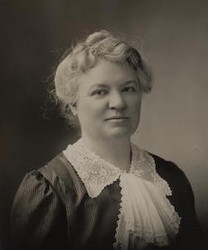
Marlborough Street looking west from Arlington Street, Circa 1880
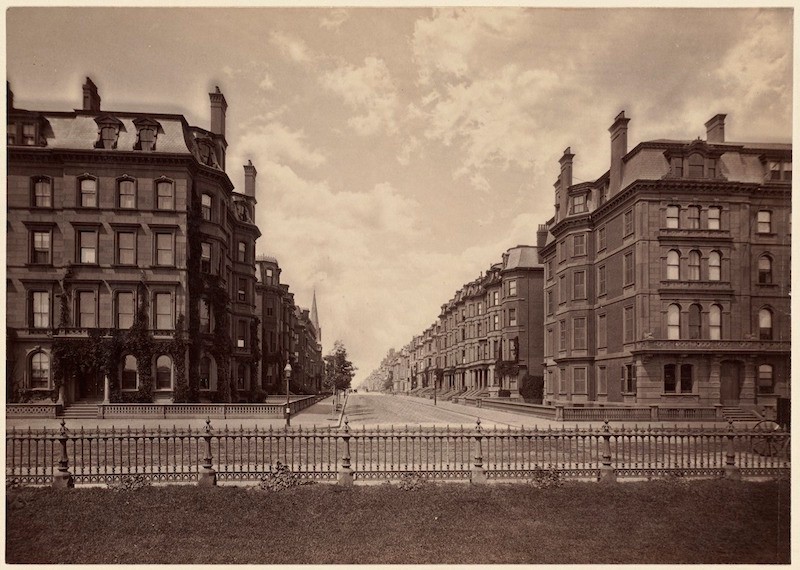
Gold satin banner on wooden pole, with gold tassels. Black type reads "Boston Equal Suffrage Association for Good Government, Founded 1901 by Pauline Agassiz Shaw"
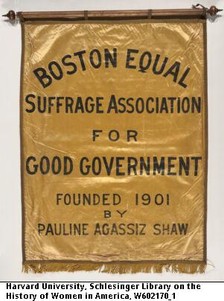
Boston Equal Suffrage Association for Good Government meeting notice; Charlotte Perkins Gilman speaking on "Equal Suffrage."
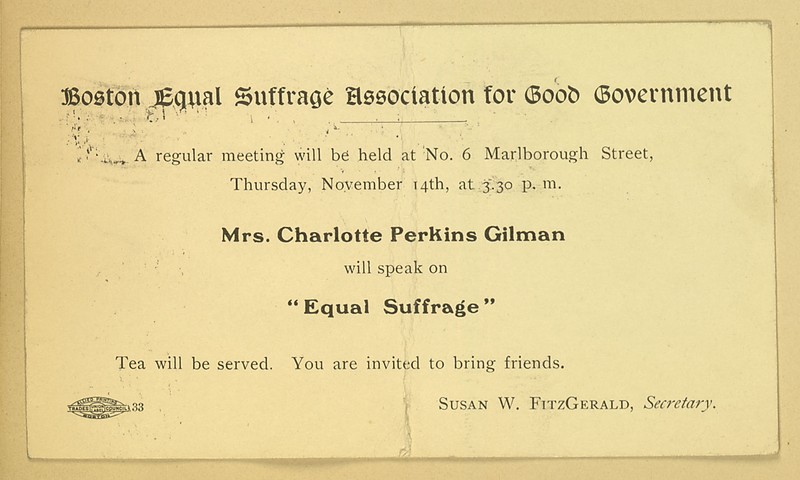
Interior shot of an almost-empty lunchroom. There are two or three seated diners and five standing waitresses. Bache, Crauston, and Lamprey seem to be eating and conversing amongst themselves, while Page is seated at at the desk with the cash box, separate from the other women.

Edna Lamprey Stantial and Mary Hutcheson Page (foreground) working in the Boston Equal Suffrage Association for Good Govenrment office. Photo mounted on page with a letter from Stantial to Page.
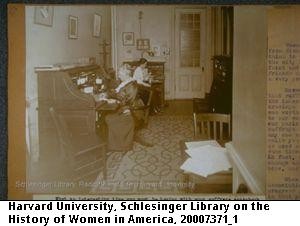
Edna Stantial, Hannah Luscomb, Eleanor Blackmur, Miss Needham, and an unidentified woman in the BESAGG office. Three desks are visible in the picture; the office looks a bit cramped.
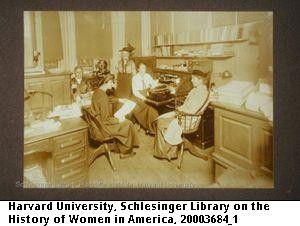
Backstory and Context
Text-to-speech Audio
Born in Columbus, Ohio in 1860, Mary spent much of her early childhood in Europe. Orphaned at sixteen, Mary was left financially well off and dedicated herself to her education. After completing finishing school, Mary studied mathematics and entered the Massachusetts Institute of Technology as a special student 1884.1 Of this time, Mary said: “I was not roused on the woman question for a long time. I went to the Institute of Technology, to study chemistry and biology. I was one of the first women to take the course there indeed, but most of the instructors were so courteous that it did not occur to me to express the awkward feeling I had that women were simply there on sufferance.”2
After marrying George Hyde Page in 1890, Mary took a class on American politics where she discovered that “our politics are bad” and lead her to “conclude that, whether women could improve them or not, men had certainly not made a brilliant success of the matter.”3 Inspired by the potential of women’s political power, Mary dedicated the rest of her life to fighting for women’s rights and women’s suffrage.
Mary cofounded the Discussion Club of Brookline, which brought woman together to discuss social problems and women’s rights. After lectures by John Graham Brooks, Col T. W. Higginson, Booker T. Washington, and William M. Salter, the club shifted its focus to suffrage and became the Brookline Equal Suffrage association in 1895.4
As chairman of the Committee for Work, a group Mary organized to raise money for Carrie Chapman Catt’s Colorado suffrage campaign, Mary identified the need for a more forward-thinking suffrage organization in Boston and began to recruit other prominent suffragists to her cause.5
In February 1901, Mary’s friend and fellow suffragist, Pauline Agassiz Shaw hosted organizational meetings here, at her 6 Marlborough Street home. On February 19th, 1901, Mary’s vision for a new type of suffrage organization became reality with the founding of the Boston Equal Suffrage Association for Good Government (BESAGG).
BESAGG was initially founded with a far-reaching agenda to improve civic life in eight areas of focus. Women’s suffrage, however, was always at its heart. BESAGG was an Auxiliary organization to the Massachusetts Woman’s Suffrage Association (MWSA), which moved its headquarters from 3 Park Street to 6 Marlborough Street in 1903, thus bringing two of the most powerful suffrage organizations in Boston together under one roof.
BESAGG was indeed a powerhouse of women in the suffrage movement from the start. Three of BESAGG’s co-founders, Pauline Agassiz Shaw, Maud Wood Park, and Mary Hutcheson Page already held powerful positions in the MWSA, which allowed them to leverage the MWSA's political power and resources. The independence of BESAGG, meanwhile, gave them the freedom to shape the future of the suffrage movement according to their own vision.
Pauline, BESAGG’s first president, was a dedicated supporter of women’s education and suffrage. Daughter of Harvard professor Louis Agassiz and wife of the wealthy mine owner Quincy A. Shaw, Pauline had the wealth to support many significant suffrage projects and organizations. Maud described Pauline as “so wise in counsel, so democratic in method, that her financial contributions to all work in which she was interested, large as they were, seemed far less important than the inspiration of her leadership.”6
Maud, BESAGG’s first secretary, was a graduate of Radcliffe College, where she had been vocal about the need to expand the women’s suffrage movement to include younger woman. She and her college friend, Inez Haynes, started the College Equal Suffrage League, which had already seen success in rallying the younger generation to the cause. After impressing Mary with her speeches and fortitude, Mary helped to secure Maud a position on the Executive Board of the Massachusetts Woman Suffrage Association.
Mary was widely recognized across the suffrage movement for her ability to identify strong leaders, engage new members, and expand the support of women’s suffrage. Her political know-how and ability to rally people to the cause helped to make BESAGG one of the most influential women’s suffrage organizations in Boston.
After returning from a nearly two year long trip to Europe with her children in June 1907, Mary was determined to grow her coalition beyond the wealthy elite that had so far defined the Boston suffrage movement. As Chairman of the Industrial Committee of the Massachusetts Equal Suffrage Association and member of the Women’s Trade Union League, Mary secured the endorsement of labor unions throughout Massachusetts, helping to increase political support for suffrage.7
Mary was particularly inspired by the English Suffrage movement, which had successfully bridged class divides and introduced new, more aggressive tactics to increase the voice and power of the suffrage movement. In 1908, Mary began corresponding with Emmeline Pethick-Lawrence, subscribed to the militant paper “Votes for Women”, and promoted the English tactics in her local parlor meetings.8
Soon, Mary began to implement more public tactics locally. In May 1909, Mary led the effort for to open a suffrage shop on Tremont Street, where the MWSA and BESAGG provided suffrage materials and gave public speeches.9 As head of the new Votes for Woman Committee, an independent organization started by the MWSA and BESAGG, Mary recruited Susan Walker Fitzgerald to hold a series of open-air meetings. Their first public meeting was held on June 12th, 1909, in Bedford, Massachusetts. Over the next two summers, the committee continued to travel around Massachusetts giving public speeches to introduce new people to their cause.10
Mary quickly became one of the most vocal supporters of the English Suffragettes in Massachusetts. When Emmeline Pankhurst, founder of the English Women’s Social and Political Union, visited Boston in October 1909, Mary hosted her for a night in her home. In an interview with the Boston Globe on October 3rd 1909, Page commended the English Suffragettes ability to “bring the question of women’s rights before the public in a more startling and convincing manner than had ever been attempted before.”11
By the time BESAGG joined the MWSA in its new home at 585 Beacon Street in 1909, Mary had successfully led the Massachusetts suffrage movement to adopt its own “more startling and convincing” voice.
Cite This Entry
Sarah Winston on behalf of Association of MIT Alumnae (AMITA). "Site of Boston Equal Suffrage Association for Good Government (BESAGG) - Founded by Pauline Agassiz Shaw, Maud Wood Park, & Mary Hutcheson Page." Clio: Your Guide to History. August 19, 2024. Accessed April 14, 2025. https://theclio.com/entry/182321
Sources
1. Strom, Sharon Hartman. “Leadership and Tactics in the American Woman Suffrage Movement: A New Perspective from Massachusetts.” The Journal of American History 62, no. 2 (1975): 301.
2. "Long an Ardent Worker, Mary Hutcheson Page." The Boston Globe, 3 October 1909
3. "Long an Ardent Worker, Mary Hutcheson Page." The Boston Globe, 3 October 1909
4. "Long an Ardent Worker, Mary Hutcheson Page." The Boston Globe, 3 October 1909
5. Boston Equal Suffrage Association for Good Government (BESAGG). Maud Wood Park notes re: organizational history, 1943, sch01035c00111d. Schlesinger Library, Radcliffe Institute. https://iiif.lib.harvard.edu/manifests/view/drs:467058028$1i. Accessed Dec. 27, 2023.
6. Boston Equal Suffrage Association for Good Government (BESAGG). Maud Wood Park notes re: organizational history, 1943, sch01035c00111d. Schlesinger Library, Radcliffe Institute. https://iiif.lib.harvard.edu/manifests/view/drs:467058028$1i. Accessed Dec. 27, 2023.
7. "Long an Ardent Worker, Mary Hutcheson Page." The Boston Globe, 3 October 1909
8. Strom, 303.
9. Massachusetts Woman Suffrage Association Records in Strom, 308
10. Strom, 309.
11. "Long an Ardent Worker, Mary Hutcheson Page." The Boston Globe, 3 October 1909
1. Mary Hutcheson Page - The Library of Congress, https://www.loc.gov/item/mnwp000145/.
2. Marlborough Street.: Digital Commonwealth, https://ark.digitalcommonwealth.org/ark:/50959/nv935g10q.
3. Banner: Courtesy of Schlesinger Library on the History of Women in America, Radcliffe Institute. http://id.lib.harvard.edu/images/olvwork602170/catalog
4. BESAGG Meeting Notice: The Library of Congress, Manuscript/Mixed Material., 14 Nov. 1907, https://www.loc.gov/item/rbcmiller001128/.
5. Lunchroom: Courtesy of the Schlesinger Library on the History of Women in America, Radcliffe Institute. http://id.lib.harvard.edu/images/olvwork20003683/catalog
6. Office: Courtesy of the Schlesinger Library on the History of Women in America, Radcliffe Institute. http://id.lib.harvard.edu/images/olvwork20007371/catalog
7. Office: Courtesy of the Schlesinger Library on the History of Women in America, Radcliffe Institute. http://id.lib.harvard.edu/images/olvwork20003684/catalog

